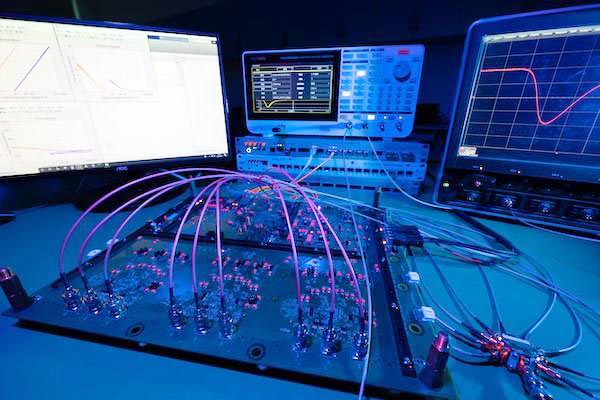LHAASO detect dozen sources of ultra-high energy gamma-rays

The electronics system deployed in LHAASO. It guarantees the resolution of LHAASO.
Credit: YANG Jianrui; MA Xiaohan; LIU Yuanbo
Discovered by Victor Hess in 1912, cosmic rays, relativisitic particles that shower Earth, contribute a signicant part of the energy density in the universe and carries unambiguous informations on various astrophysical processes . Yet until now, origin of cosmic rays is still a mystery.
A key problem in understanding the origin of cosmic rays is the searching for the acceleration site up to or even beyond Ultra-high energy (UHE). Such extreme accelerators are dubbed as PeVatrons. However, composed of subatomic particles, such as protons or atomic nuclei, cosmic rays are charged and lose the direction information in propagating in the magnetic field in the interstellar medium, which make it impossible to identify the PeVatrons from direct cosmic ray measurement. On the other hand, UHE γ-rays, those fall in peta-electronvolt (1015 eV) range, are produced unavoidably inside or in the vicinity of PeVatrons. γ-rays are not charged and travel straight , thus they can be regarded as the straightforward signature to identify PeVatrons.
A new observatory, the Large High Altitude Air Shower Observatory (LHAASO) located at Sichuan, China, detected dozen Ultra-high Energy gamma-ray sources, opening a new window into the γ-ray sky, which indicate that the existence of a population of PeVatrons in our Galaxy.
In this article, though not fully installed, the half Kilometer Square Array (KM2A), one of the three interconnected detectors that constitute LHAASO, reported 12 PeVatrons with the statistical significance greater than 7 standard devition after observation using 11 months data. Of these sources, two have been detected with energy over 0.8 PeV, an energy equivilant to accelerate an electron with electric potential of 0.8 million billion electronvolts, and one with highest energy exceeded 1.4 PeV.
The 12 γ-ray emitting regions identified by LHAASO prompts the presence of active or recent PeVatrons. Team led by Professor YANG Ruizhi from the University of Science and Technology of China discussed some possible candidates, including pulsar wind nebulae, supernova remnants and star-forming regions, with multi-wavelength data.
To support the detection of UHE γ-rays, the team led by Professor LI Cheng from the University was responsible for the design and quality assurance/check of over 3000 high-dynamic-range large-size photodetectors for muon detectors of KM2A and Water Cherenkov Detector Array (WCDA), another component of LHAASO.
The team led by Professor AN Qi from the University designed, tested, and installed the readout electronics system for the 8” and 20” PMTs in WCDA, which achieves high precsion time and charge measurement over a large input dynamic range of 1 Photon Electron (P.E.) ~4000/2000 P.E..
Full article was published on Nature.
With comprehensive multi-wavelength data, researcher will be able to firmly identify and locate PeVatrons in the future. Longer observation and full installation of LHAASO is also expected to provide more detailed information on reported PeVatrons and to discover even more PeVatrons, which would advance the understanding of the origin of cosmic rays.
All latest news from the category: Physics and Astronomy
This area deals with the fundamental laws and building blocks of nature and how they interact, the properties and the behavior of matter, and research into space and time and their structures.
innovations-report provides in-depth reports and articles on subjects such as astrophysics, laser technologies, nuclear, quantum, particle and solid-state physics, nanotechnologies, planetary research and findings (Mars, Venus) and developments related to the Hubble Telescope.
Newest articles

Tackling Life-Threatening Fungal Infections Using RNA Modifications
Importance of RNA modifications for the development of resistance in fungi raises hope for more effective treatment of fungal infections. An often-overlooked mechanism of gene regulation may be involved in…

Unraveling Aphasia: Global Study Breaks Down Patients’ Struggle with Verb Tenses
An international team of researchers, including scientists from the HSE Centre for Language and Brain, has identified the causes of impairments in expressing grammatical tense in people with aphasia. They discovered…

Facing the Storm: A Prepped Up Future Against Extreme Climatic and Weather Changes
From the persistent droughts of southern Africa and Central America in the early part of the year to the more recent devastating extreme rainfall in Spain and the deadly Hurricane…



